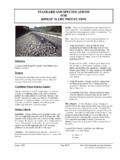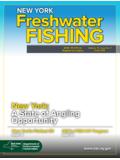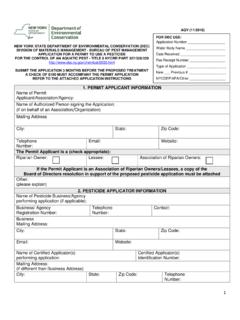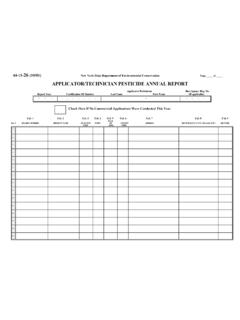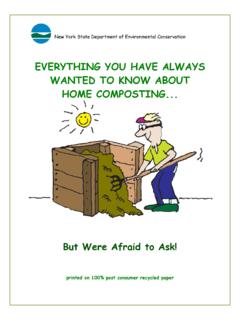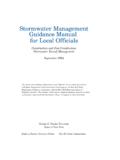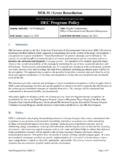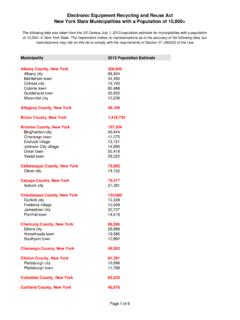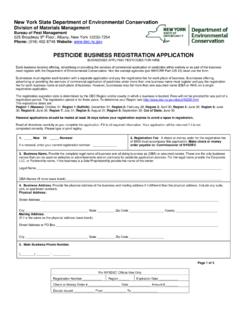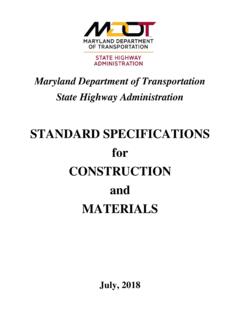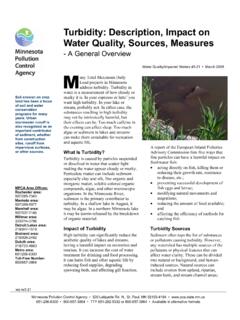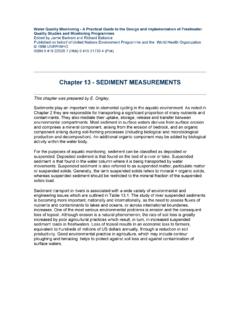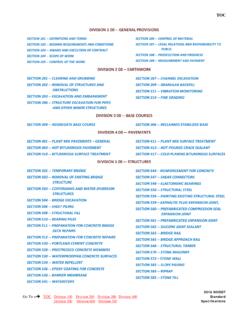Transcription of SECTION 5 SEDIMENT CONTROL CONTENTS
1 SECTION 5 SEDIMENT CONTROL CONTENTS Page List of Tables and Figures Scope and Discussion .. Chemical Treatment .. Buffer Filter Strip .. Cofferdam Structure .. Compost Filter Sock .. Dewatering Device .. Geotextile Filter Bag .. Rock Dam .. SEDIMENT Basin .. SEDIMENT Dike .. SEDIMENT Tank - Portable .. SEDIMENT Trap .. Silt Fence .. Storm Drain Inlet Protection .. Straw Bale Dike .. Turbidity Curtain .. SECTION prepared by: Donald W. Lake Jr., , CPESC, CPSWQ Former Engineering Specialist New York State Soil & Water Conservation Committee Adjunct Assistant Professor State University of New York, College of Environmental Science and Forestry List of Tables and Figures Table Title Page Compost Sock Fabric Minimum Specifications Table.
2 Compost Standards Table .. Figure Title Page Buffer Filter Strip .. Compost Filter Sock .. Skimmer Orifice Design Chart .. Skimmer Dewatering Device .. Riser Pipe Dewatering Device .. Riser Pipe Dewatering Device Construction Notes .. Rock Dam .. Pipe Spillway Design .. SEDIMENT Basin .. Riser Inflow Chart .. Pipe Flow Chart; n = .. Pipe Flow Chart; n = .. Concentric Trash Rack and Anti-Vortex Device.
3 Concentric Trash Rack and Anti-Vortex Device Table .. Riser Base Detail .. Anti-Seep Collar Design .. Anti-Seep Collar Design Charts .. Anti-Seep Collar .. Design Data for Earth Spillways .. Design Table for Vegetated Earth Spillways in erosion Resistant Soils .. Design Table for Vegetated Spillways Excavated in Very Erodible Soils .. SEDIMENT Basin Baffle Details .. SEDIMENT Dike .. Portable SEDIMENT Tank .. Pipe Outlet SEDIMENT Trap: ST-I .. Pipe Outlet SEDIMENT Trap: ST-1 - Construction Specifications .. Stone Outlet SEDIMENT Trap: ST-II .. Compost Sock SEDIMENT Trap: ST-III.
4 Optional SEDIMENT Trap Dewatering Devices .. Reinforced Silt Fence .. Excavated Drop Inlet Protection .. Fabric Drop Inlet Protection .. Stone & Block Drop Inlet Protection .. Straw Bale Dike .. Turbidity Curtain .. New York State Standards and Specifications Page November 2016 For erosion and SEDIMENT CONTROL SEDIMENT CONTROL Scope and Discussion SEDIMENT CONTROL is the second component in the site management plan after erosion CONTROL . Primary emphasis should be placed on erosion CONTROL first which combines runoff CONTROL and soil stabilization to minimize soil erosion . SEDIMENT CONTROL practices are then integrated into the plan to further reduce the migration of eroded soil both on and off site.
5 The majority of SEDIMENT CONTROL practices utilize settling to capture SEDIMENT within a storage volume where it can be contained and managed. These practices include SEDIMENT basins, SEDIMENT traps and dikes, rock dams, water structures, silt fence, turbidity curtains, straw bale dikes, and portable settling tanks. There is also a group of practices that rely on both filtering and settling to capture SEDIMENT . These practices include storm drain inlet protection structures, geotextile filter bags, compost tubes, and buffer filter strips. In addition, the use of chemical polymer substances is a process that may, with NYSDEC approval, be used on sites where disturbed clay soils remain in suspension. It is important that these SEDIMENT CONTROL practices be designed, constructed and installed in accordance with the criteria contained in these standards.
6 For these practices to effectively remove SEDIMENT from turbid water, the volumes, dimensions, and appropriate attributes of these individual practices must be maintained. This includes the calculated relationships of dimensions to respective drainage areas, length to width ratios, and frequency of inspection and maintenance. To assist with the success of these SEDIMENT CONTROL practices, apply the following concepts for the practice design and location: 1. Keep the clean water clean by diverting runoff from upslope areas away from disturbed areas. 2. Employ natural vegetative buffers or artificial mats to assist in SEDIMENT capture in sheet flow areas. 3. CONTROL concentrated flow to minimize additional erosion that could overwhelm a practice. 4. Stabilize all SEDIMENT CONTROL systems as soon as they are installed so they do not contribute SEDIMENT to site runoff.
7 5. Remove all practices after use and stabilize the regraded areas immediately. SEDIMENT accumulated in the SEDIMENT CONTROL practices must be removed when the SEDIMENT has filled the designated storage volume for the practice. The material must be disposed of in a manner that stabilizes it on the construction site. These details, as well as the frequency of inspection, sequences of installation and removal, and an inspection checklist shall be included in the Stormwater Pollution Prevention Plan for the site. Chemical Treatment Precipitation of SEDIMENT is enhanced with the use of specific chemical flocculants that can be applied to a SEDIMENT basin in liquid, powder, or solid form. Flocculants include polyacrylimide, aluminum sulfate (alum), and polyaluminum chloride. Polymer flocculation shall only be used for dispersive soil-water mixtures that do not respond to normal settling times when allowed to set in SEDIMENT traps and basins, less than 7 days.
8 Controlled application takes place in a SEDIMENT basin or trap with anionic polyelectrolytes in the form of liquid, powder, or solid form, such as polyacrylimide, aluminum sulfate, chitosan lactate, or chitosan acetate. Cationic polyelectrolytes have a greater toxicity to fish and other aquatic organisms than anionic Note: Performing activities within or adjacent to wetlands, streams and waterbodies may require permits from the New York State Department of Environmental Conservation (NYSDEC) pursuant to Article 15 (Protection of Waters), Article 24 (Freshwater Wetlands) and Article 25 (Tidal Wetlands) of the Environmental Conservation Law (ECL). Project owners should contact NYSDEC s Regional Division of Environmental Permits early in the site planning process to discuss the requirements for meeting permit issuance standards. Following the New York State Standards and Specifications for erosion and SEDIMENT CONTROL may not ensure compliance with the above referenced sections of the ECL.
9 November 2016 Page New York State Standards and Specifications For erosion and SEDIMENT CONTROL polyelectrolytes because they bind to the gills of fish resulting in respiratory failure (Pitt 2003). Chemical treatment shall not be substituted for proper planning, phasing, sequencing, and the design of appropriate erosion and SEDIMENT CONTROL practices. No polymer application shall take place without written approval from NYSDEC. Field tests must be conducted on the proposed site at the design basin locations with the tributary soils to establish polymer dosing rates and verify settling performance.
10 Treated water discharged from SEDIMENT basins with polymer treatment will be tested to determine that any residual polymer meets the standards set by NYSDEC. Polymer flocculation systems require daily inspection. New York State Standards and Specifications Page November 2016 For erosion and SEDIMENT CONTROL STANDARD AND SPECIFICATIONS FOR BUFFER FILTER STRIP Definition & Scope A temporary/permanent well vegetated grassed area below a disturbed area that can be used to remove SEDIMENT from runoff prior to it reaching surface waters or other designated areas of concern, such as parking lots and road pavement. Condition Where Practice Applies This practice is effective when the flow is in the form of sheet flow and the vegetative cover is established prior to disturbance. Surface water must be protected from sedi-ment-laden runoff until buffer filter strip vegetation is es-tablished, and then the proposed disturbance can be under-taken.
